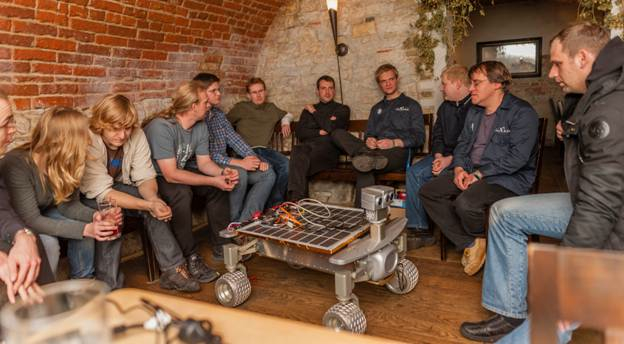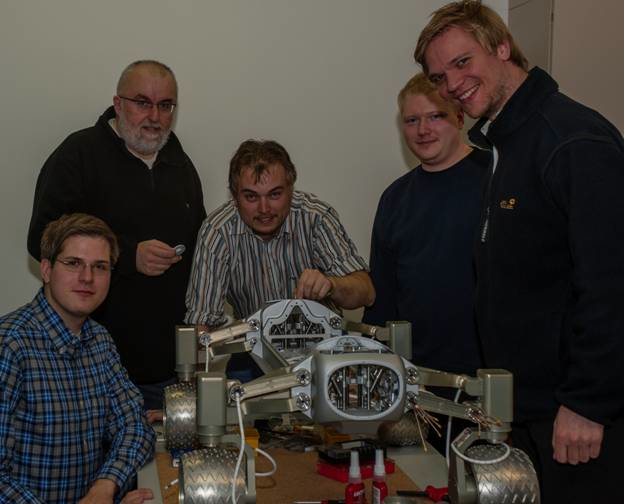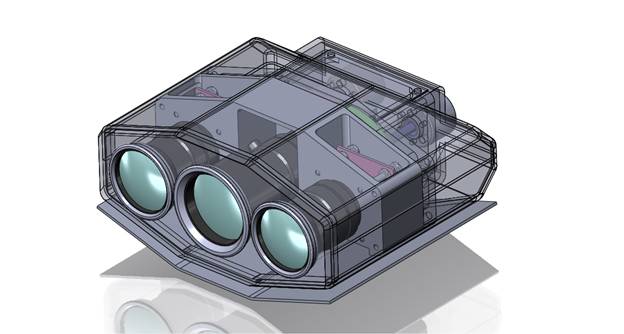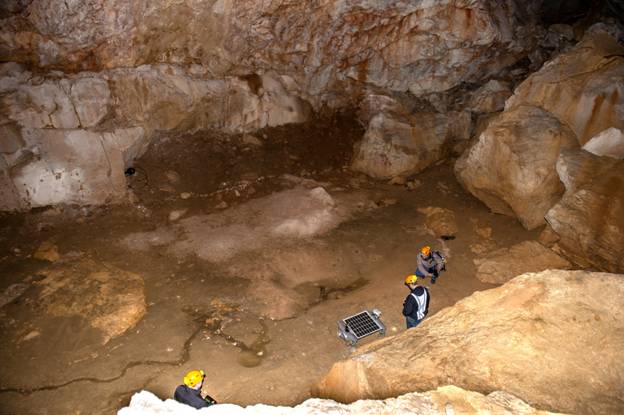
'Part-Time Scientists' Look to Fast-Track Space Exploration (Op-Ed)
Robert Böhme, co-founder, Part-Time Scientists. He contributed this article to Space.com's Expert Voices: Op-Ed & Insights.
In 2008, my colleagues and I formed The Part-Time Scientists to compete for the $20 million Google Lunar XPRIZE , an international competition to inspire low-cost commercial space exploration, build a foundation for private space exploration and radically transform spaceflight from a government-owned venture to an entity with open access to all.
Space exploration has floundered in recent decades due to declining public research budgets. Before we formed the Part-Time Scientists, my colleagues and I were concerned observers of this trend, as were the minds behind the Google Lunar XPRIZE (GLXP). We believe it is vitally important to the prosperity of humankind that the outward push to explore and exploit space does not falter under these circumstances, and we feel that the GLXP was created in a similar sentiment. A core belief inspired us to take the leap and commit a large amount of our personal resources to remedying this situation: we believe that our contribution can help provide the impulse and foundation to create a burgeoning private space industry, set apart from the publicly funded efforts and their risk-averse, overly engineered mentality.

We frequently get inquiries on how our efforts compare to the publicly funded ones, e.g. how do the rover or camera we are developing compare to NASA's Curiosity of China's Yutu missions? Budget numbers for China's Chang'e-3 mission are not publicly available, so we cannot make a good comparison — however, NASA provides the budget for their Curiosity rover development, and it was close to $2.5 billion. While the mission provides excellent science, and the multi-stage, soft-landing approach was brilliant engineering, this is indeed the type of mission we want to move away from due to the cost and development time involved.
The full-time scientists at NASA designed Curiosity for several years and spent nearly $2.5 billion. While the Part-Time Scientists also worked for several years on Asimov, our rover, we have spent only about $500,000 on its development to date. Our rover is not yet complete, and our mission has not yet been accomplished unlike Curiosity's, but our development model demonstrates an alternative to the increasingly rare publicly funded missions.

We use rapid prototyping, integrate off-the-shelf technology, and conduct our own radiation testing with help from some of our partners, and to the benefit of some of our other partners. It is important to note that we use smaller safety margins than NASA, and do not test and certify every single component, instead focusing on the biggest risks and impacts. Because we do not require all of our components to be certified, we can use advanced materials and manufacturing techniques to reduce cost and development time. In effect, our holistic, mission-certification process is to launch a mission — if it succeeds, its components were space-worthy. If it does not, we need to analyze the data and find which system or component was not space-worthy, address the problem and repeat the mission. Our present budget is 5,000 times less than that of Curiosity, and we feel confident that we could work out all the kinks in our mission in fewer than 5,000 tries.
In 2013, when the Google Lunar XPRIZE announced interim Milestone Prizes for approaches to getting the mission to the moon (Landing Prize), roving on the moon (Mobility Prize) and showing the moon in HD video to those watching on Earth (Imaging Prize), the judging panel selected ours as one of five teams to compete for both the Mobility and Imaging Prizes. [5 Private Moon-Race Teams Compete for Bonus $6 Million ]
Sign up for the Live Science daily newsletter now
Get the world’s most fascinating discoveries delivered straight to your inbox.

Our camera unit is based on three CMOSIS CMV4000-R2 sensors and three Schneider-Kreuznach lenses in a single package that simplifies integration with the rest of a mission. Two of these cameras work as a pair to allow 3D images to be created from their data; the assembly of the third camera includes a filter wheel for scientific purposes. The camera unit's design allows it to enhance a range of missions, from providing vision for a rover to providing localization to a deep-space craft (via star charts) to mapping an asteroid via several fly-bys.
Much of our design philosophy has focused on lowering the mission cost, which generally means reducing development cost and weight. Development cost is kept low by extending, adapting and integrating commercial, off-the-shelf (COTS) components, rather than developing bespoke solutions from scratch, and sharing the value added back with our partners. Launching cost is dominated by weight. A small size makes the camera unit easier and cheaper to integrate into a vessel, and reduces weight. Our camera sensors also each consume less than 1 watt during operation, which lowers overall power requirements and allows for a smaller, lighter-power plant or battery.
Our camera has a resolution of about double that of the cameras used on the Apollo missions. Higher resolutions are certainly available, but we need to keep several factors low: unit cost, integration effort, sensitivity to radiation and computational post-processing requirements. So we set our minimum for our first effort comparable to the last devices brought to the moon. Our goal is to provide sufficient technology to accomplish a wide range of missions at a greatly reduced cost to the mission carrier — not to exceed the state of the art and set a new record for high-resolution space imagery. We are not competing in engineering, but in our ability to realize a successful mission at greatly reduced cost and shorter development time.

We improve on the Apollo cameras by using two cameras for stereoscopic imaging, which enables construction of 3D models of the lunar surface. We also added a filter wheel to the third camera to allow for various colors and scientific filters. For example, several lunar minerals can be identified by how they absorb infrared light, and an appropriate filter will reveal the distribution of these minerals in the area we will survey. We also use a third camera with a telephoto lens; we can change the focus of this camera to as close as 500mm by moving the camera sensor closer or further from the lens. We considered a zoom lens instead of the telephoto lens, but had to reject this method due to considerably higher integration costs. Many of these features were used on the several camera assemblies of the Curiosity rover; however, our aim is to provide the most useful set of features for surveying space at greatly reduced cost in a single package, which also lowers integration cost and time.

Independent of the outcome of the Google Lunar XPRIZE, we aim to commercialize this technology and contribute to building a foundation for a private space exploration industry. Interestingly, we are having our first successes at making this technology available through the Google XPRIZE competition, without outside funding. One of our competitors, Team Puli, and one other team are looking into licensing our camera solution for their future lunar missions, including for the Google Lunar XPRIZE and also space efforts outside the competition. This gets them a camera unit that will meet the GLXP requirements without all of the development and testing cost, and the licensing allows the Part-Time Scientists to defray some of that development and testing cost.
We expect this kind of cross-team cooperation to increase as the current deadline of the competition (the end of 2015) draws nearer, especially since rocket launches need to be scheduled and paid for many months in advance. The Milestone Prizes were intended to recognize the technological achievements and financial hurdles faced by the teams as they prepare their lunar mission, and inject new energy into the competition. We think it's working, and our schedule is rapidly filling up. This looks to be exciting year for the Google Lunar XPRIZE, the teams and spectators.
May the best team win.
The views expressed are those of the author and do not necessarily reflect the views of the publisher. This version of the article was originally published on Space.com.









